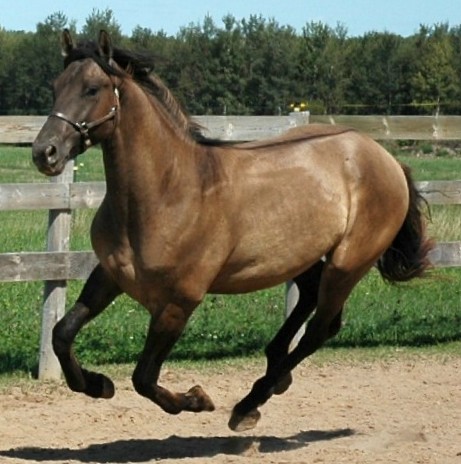
Horse breeds and colors come in and out of fashion like most other things. At the moment, cowboys like having a dun colored horse.
The dun gene is a dilution gene that affects both red and black pigments in the coat color of a horse. The dun gene has the ability to affect the appearance of all black, bay, or chestnut (“red”)-based horses to some degree by lightening the base body coat and suppressing the underlying base color to the mane, tail, legs and “primitive markings.”
The classic Dun is a gray-gold or tan, characterized by a body color ranging from sandy yellow to reddish-brown. Dun horses always have a dark stripe down the middle of their back, a tail and mane darker than the body coat, and usually darker faces and legs
From the Ultimate Horse Site website:
The Dun dilution gene acts a bit like the cream in that it dilutes pigments, but it acts very differently on different bases. Dun will dilute red pigment slightly to a pale/creamy red color. This gene also creates one or several dun factors, the most common and essential one being the dorsal stripe. All duns have a dorsal stripe (but not all horses with a dorsal are duns). Some dorsal stripes are not created by the dun gene, but rather are from the counte rshading effect or sooty gene. Such a “fake dun” will not have other dun factors like leg striping, and will not have the lightening of pigment like a dun.
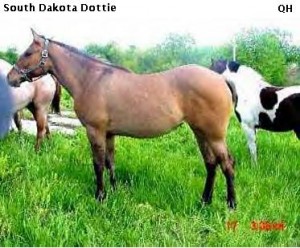
Bay dun South Dakota Dottie, owned by Michele Baade
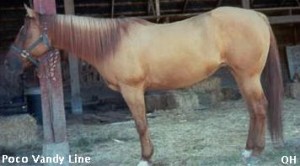
Pocos Vandy Line, QH from Amy Arciniega. A red dun showing diluted body and frosting in the mane.
The most well-known shade of dun is the yellow dun, which more appropriately should be called a bay dun. This is the dun on a bay base; the body is usually a yellow or tan color, and the points are dark.
Sometimes bay on dun will not result in a yellow color, and the body will look like a bay– except for a dark dorsal stripe and other dun factors.
Dun on a chestnut creates a red dun. The body is a red and is sometimes diluted to a very light red, and the dorsal and dun marks are a dark (undiluted) red color. On a seal brown, dun can make a muddy-brown dun color (called Mouse dun), or a brownish/green grulla (sometimes called Olive grulla).
Now, we come to dun on black. Technically, it is called black dun, not a very original name. However, in the Quarter horse and especially Western world, it is known as Grulla, after the Spanish word for a blue-gray crane. This is the most widely used term for this color. And, of course, the correct pronunciation is Spanish– “Grew-ya”. You may have heard it spelled “Grullo”. This is a new word that was created for a more masculine sound, and in many places it has common usage.
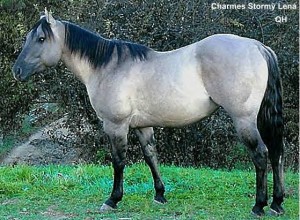
Charmes Smoky Lena, grulla stallion, owned by Ronda Shafer. Website: SmokinAcres.com
In Iceland and other parts of the world, this color is called Blue Dun.
In the USA, the lightest shade of black dun is called “Silver Grullo”, then comes “Slate Grullo”, then “Grullo”, then “Lobo dun”, with the last being the darkest shade.
So just what color is Grulla? It’s often described as a mousy-gray, smoky-blue, or slate-gray color. The black is diluted by the Dun gene to an off-black, bluish, smoky-gray color; in some cases, the horses are more mousy-brown-tan, and in even more other cases, the horses are the color of the inside of a Three Musketeer candy bar.
The dorsal is black, and the face and legs are often darker than the body.
Grulla is kind of hard to describe, but once you’ve seen a few you will be able to identify them.
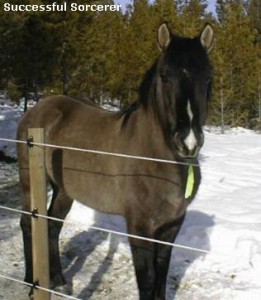
Successful Sorcerer, grulla morgan, owned by Traci Stanley
Some breeders consider Grulla to be the rarest of the dun colors– are some are even bold enough to state that they are “the rarest Quarter Horse color”, although this is not true. They probably are the rarest of the dun colors, however, as first you need a black base, then a dun gene over that. And as black is recessive to Agouti (creates bay), this makes it rarer.
The Norwegian Fjord is a breed that comes only in shades of dun; They are a very ancient and primitive breed believed to be descendants of the Tarpan and Przewalski’s horse. Their dun is actually different than the regular dun found in, say, Quarter Horses– at least in the visual sense. They have ‘black duns’ and ‘red duns’, but they do not look anything like those appearing in most other breeds. They are a very unique breed, instantly recognizable by their color and conformation.
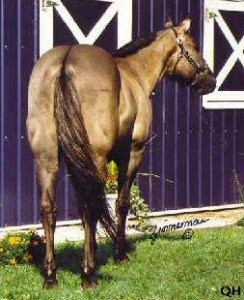
Grulla Photo by Michele Zimmerman

Grulla colt, from Barbara Lamphere, tequilahorses.com
Dun Shades

This Quarterhorse stallion died at age three… was owned by Joe Shoemaker of Norphlet, AR. Pic was sent in by Jennifer Thomson.
Dun on different bases will create different shades. The base and dun acting together create the final color. Here are what some bases + dun look like:
CHESTNUT + DUN:
This is called a red dun, and some shades are sometimes called “apricot dun” or “peach dun”. The red body color is slightly diluted, and the dun marks are a dark red (as the genotype is ee, there is no black pigment, so dun instead creates red stripe/marks).
BAY + DUN:
This creates a bay dun, also called a ‘yellow dun’ or sometimes ‘zebra dun’. The body color is usually diluted to a yellow color, although sometimes the body remains very red. This is the most common dun. The dun marks are black.
BLACK + DUN:
This is called Grullo/a depending on horse’s sex (‘a’ is female’); it is also called black dun, blue dun, slate grullo, silver grullo, silver dun, or lobo dun. This is often considered the rarest shade of dun. The black coat is diluted to a mousy-gray, but the coat can be silver-smoky, bluish, or sometimes a mousy-brown.
BROWN + DUN:
Called “Mouse dun”, or sometimes “olive grullo”, “muddy grullo”, or “wolf dun”. The body is a muddy-tan or brown color, not as yellow as a bay dun and not as silver as a grullo.
Besides the base colors, dun can act in conjunction with other dilutes and patterns. There are dunalinos (palomino + dun) dunskins (buckskin + dun), and dun cremellos and perlinos… the list goes on. Dun, like almost every other modifying gene, can show up on any colored horse, not just base colors.

